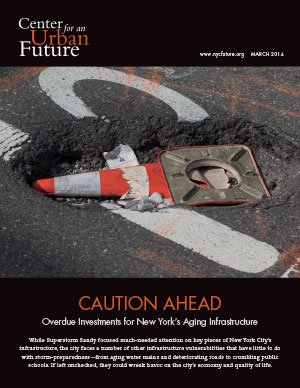Our March 2014 Caution Ahead report shined a light on New York City’s aging infrastructure and detailed numerous vulnerabilities across the city’s transportation, utility and building assets. The report is already beginning to influence city policies.
Among the report’s recommendations, we urged the de Blasio administration to increase funding for road resurfacing. The report pointed out that while NYC DOT sets a goal of resurfacing 1,000 lane miles of city streets each year, the agency had fallen short of this target on all but three occasions since Fiscal Year 2000. Moreover, we showed the condition of city streets were deteriorating, even before the harsh winter: in 2013, 30.4 percent of the city’s roads received a “fair” or “poor” rating, up from 15.7 percent in 2000. Council Member Daniel Garodnick ran with our recommendation, using data from our report as evidence to urge Mayor de Blasio to provide DOT with the funding necessary to service at least 1,000 lane miles. In May 2014, the Mayor did just that, adding $49 million to his preliminary capital budget for a total of $226 million to ensure that that 1,000 lane miles are resurfaced in Fiscal Year 2015.
Our Caution Ahead report has also impacted a number of other areas. After we recommended that the city lease space on city owned pay phones to improve broadband access, the de Blasio administration issued an RFP to replace public pay telephones with a citywide network of Wi-Fi hotspots. Additionally, at a forum held by the Center for an Urban Future and City & State around the findings our report, Feniosky Pena-Mora, commissioner of the NYC Department of Design and Construction (DDC), endorsed recommendations we made for the renewal of project labor agreements for city construction, a stronger emphasis on life-cycle rehabilitation and maintenance costs, and the pre-qualification of public works contractors based on credentials, experience and past performance. “The recommendations that Center for an Urban Future presented are very important,” said Commissioner Pena-Mora. “For example, we are talking about a PLA, how to support an extension of the PLA to our programs. We are working on extending [the PLA] and renegotiating it and ensure the coordination of the different contractors. We also wanted to take some of the other [CUF] recommendations that have been presented in terms of how we organize some of our projects, how we get the approvals and how we ensure we get the best qualified contractors.”



